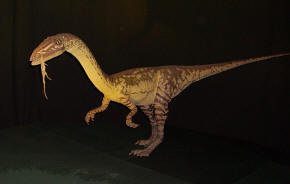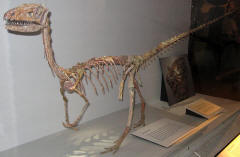|
Description
Coelophysis bauri
is known from a number of complete fossil skeletons.
C. bauri was a lightly
built dinosaur which measured up to 3 metres (9.8 ft) in length
and which was more than a meter tall at the hips. The name
Coelophysis means "hollow
form" or "hollow
process", so named
because of its hollow limb bones.
Coelophysis
was very slim and it probably would have been a fast runner. Despite being
an early dinosaur, the evolution of the theropod
body form had already
advanced greatly from creatures like
Herrerasaurus and
Eoraptor. The torso of
Coelophysis
conforms to the basic theropod body shape.
Coelophysis
had large eyes and good eyesight. Its neck and
head were long. The tail was also long, and had
an unusual structure within its interlocking
prezygapophysis of its
vertebrae, which formed a semi-rigid lattice, apparently to stop the tail
from moving up and down. This may have let the
tail act as a rudder or counterweight when the animal was maneuvering at
high speeds.
Coelophysis
had a long narrow head, and its sharp, curved, jagged teeth show that it ate
meat - probably the small, lizard-like animals that were found with it.
It may also have hunted in packs to tackle larger prey.
Coelophysis had an
elongated snout with large
fenestrae which helped
to reduce skull weight, while narrow struts of bones preserved the
structural integrity of the skull. The neck had a pronounced
sigmoid curve.
Paleobiology
The teeth were typical of predatory
dinosaurs, blade-like and recurved with fine serrations on both
anterior and
posterior edges.
Since knowledge of
Coelophysis comes mainly
from the specimens excavated at
Ghost Ranch, there is a
tendency to see this massive congregation of animals as evidence for huge
packs of Coelophysis
roaming the land. The television series
Walking with Dinosaurs,
for example, showed small flocks together (and did not cite the Ghost Ranch
deposits as evidence). No direct evidence for flocking exists; the deposits
only indicate that large numbers of Coelophysis,
along with other Triassic animals, were buried together. Some of the
evidence from the
taphonomy of the site
indicates that these animals may have been gathered together to feed or
drink from a depleted water hole or to feed on a spawning run of fish,
and then became buried in a catastrophic flash flood.
It has been suggested that
C. bauri was a cannibal, based on
supposed juvenile specimens
 |
| Animatronics model demonstrating supposed canibalistic behavior
(Picture
Source) |
found "within" the abdominal cavities of some
Ghost Ranch specimens. However, Rob Gay showed in 2002
that these specimens were misinterpreted (several specimens of "juvenile coelophysids" were actually small
crurotarsan reptiles
such as
Hesperosuchus, and it
appears that in some cases bigger individuals were crushed on top of smaller
ones), and there is no longer any evidence to support cannibalistic behavior
in Coelophysis.
Gay's study was corroborated in 2006 in a subsequent study by Nesbitt
et al. There may be other
evidence coming to light that may show stomach contents from some of these
specimens, which might bring greater resolution to the subject.
Two forms of
Coelophysis have been
found, a more
gracile form and a
slightly more robust form. Opinion among paleontologists is now
that these were female and male variants.
History of
discovery
Edward Drinker Cope
first named Coelophysis
in 1889 during his competition to name species
with
Othniel Charles Marsh,
known as the "Bone
Wars". An amateur fossil collector, David
Baldwin, had found the first remains of the dinosaur in 1881. The type species,
C. bauri was named for
Baur, one of the many fossil collectors who supplied Cope. However, these
first finds were too poorly preserved to give a complete picture of this new
dinosaur.
In 1947, a substantial 'graveyard'
of Coelophysis
fossils was found in New Mexico, at the
Ghost Ranch, close to
the original find. So many fossils together were probably the result of a
flash flood, which swept away a large number of
Coelophysis and buried
them quickly and simultaneously. In fact, it seems such flooding was
commonplace during this period of the Earth's history and,
indeed, the
Petrified Forest of
nearby Arizona is caused by a
preserved log jam of tree trunks that were caught in one such flood. Edwin H. Colbert made a
comprehensive study of all the fossils found up
to that date, and it is from him that we take most of our information about
Coelophysis. The
Ghost Ranch specimens were so numerous, including many well-preserved
specimens, that one of them has since become the diagnostic, or type specimen, for the
entire genus, replacing the original, poorly preserved specimen (see
Classification below).
Since the Ghost Ranch specimens were
discovered, more skeletons have been found in Arizona, New Mexico and an
as-yet unconfirmed specimen from Utah, including both
adults and juveniles, the deposits where
Coelophysis has been
discovered date from the late Carnian to the early
Norian
faunal stages of the
Triassic Period.
Edwin H. Colbert has suggested that
Connecticut Valley theropod footprints referred to the
ichnogenus
Grallator may have
been made by Coelophysis.
Classification
Coelophysis
is a distinct taxonomic unit (genus),
composed of a single species, C. bauri.
In popular
culture
Coelophysis
were featured in the BBC television series
Walking with Dinosaurs,
When Dinosaurs Roamed America
and in Dinosaurs Alive
(where they hunt an
Effigia). The 1974
children's television series
Land of the Lost also
featured a Coelophysis,
nicknamed "Spot".
Coelophysis
was the second dinosaur in space. Although
Maiasaura had been
taken into space three years earlier, a
Coelophysis skull from the
Carnegie Museum of Natural History
was aboard the Space Shuttle Endeavour
mission STS-89 when it left the
atmosphere on January 22, 1998. It was also taken onto the space station
Mir before being
returned to Earth.
Coelophysis
is also the
state fossil of New Mexico.
Return to the
Old Earth Ministries Online Dinosaur
Curriculum homepage.

Shopping Results for
Coelophysis fossil reproductions
Bay
State Replicas - Coelophysis skull (Click on "Fossil Reproductions,"
then "Skull")
|






